Introduction
World War II was the worst war in history and killed more people than any other war before. It lasted from 1939 to 1945 and, starting out from Europe, spread to nearly every part of the world .
About 17 million soldiers died during six years of the war. Even more civilians – men, women and children – died from bomb attacks, illnesses or starvation. Millions of Jews died in German concentration camps. The war left many other people without jobs and homes.
Many cities and industries in Europe and Asia were completely destroyed by bombs and large areas of land were devastated.
Causes of World War II
There are many causes of the war and some of them go back to the end of the First World War. The end of World War I and the peace that followed in 1919 changed the face of Europe and the borders of countries completely. New nations emerged and countries that lost the war, especially Germany and Austria had to give up a lot of land. They also had to pay money to other countries for the damages and destruction that happened during the war.
Economic Problems
After the war many countries were in debt. The losers had problems paying reparations and the winners borrowed a lot of money from the United States which they could not pay back. Inflation in many countries left people without any savings. In the 1930s the Great Depression, starting out in the USA, spread to Europe and stopped the continent’s recovery. Millions of people were out of work and poverty rose.
Feeding the poor in Germany in 1931
Image : Bundesarchiv, Bild 183-T0706-501 / CC-BY-SA 3.0, CC BY-SA 3.0 DE,
via Wikimedia Commons
Political Movements
The problems after the war made the governments in many countries weaker and weaker. Two movements became more and more powerful: Communism, known as “the Left”, called for a revolution of the working class. Fascism, known as “the Right”, wanted a strong national government
The Axis and Allied Powers
Two groups of nations fought against each other during the Second World War.
During the 1930s Germany, Italy and Japan led a group of nations called the Axis. The leaders of these countries were dictators. They wanted their own countries to grow and others to become weaker. In the years before the beginning of World War II all three Axis powers had strengthened and modernized their armies.
In the 1930s the Nazi Party rose to power in Germany. In 1933 the party’s leader Adolf Hitler was appointed chancellor and became known as “der Führer”. He promised to take revenge on the countries that had defeated Germany in the First World War and make Germany the most powerful country in the world. He also claimed that only Germans were the true race and wanted to get rid of Jews, Communists, and other weaker people.
In Italy Benito Mussolini, known as the “Il Duce”, became the leader of the Fascist Party, which gained many supporters. He promised to bring law and order to the country and help solve its economic problems.
The Axis Powers invaded other countries and expanded their territory. At the beginning of the 1930s Japan invaded Manchuria because it had a lot of raw materials. In 1938 it attacked China and later on expanded to Southeast Asia. In 1935 Italy took over Ethiopia. Germany started its conquest of foreign territories by invading Austria. Italy and Germany also sent soldiers to help another dictator, Francisco Franco, in the Spanish Civil War.
The Allies were made up of a total of 50 countries. They were led by Great Britain, the Soviet Union, France, China and the United States and opposed the Axis.
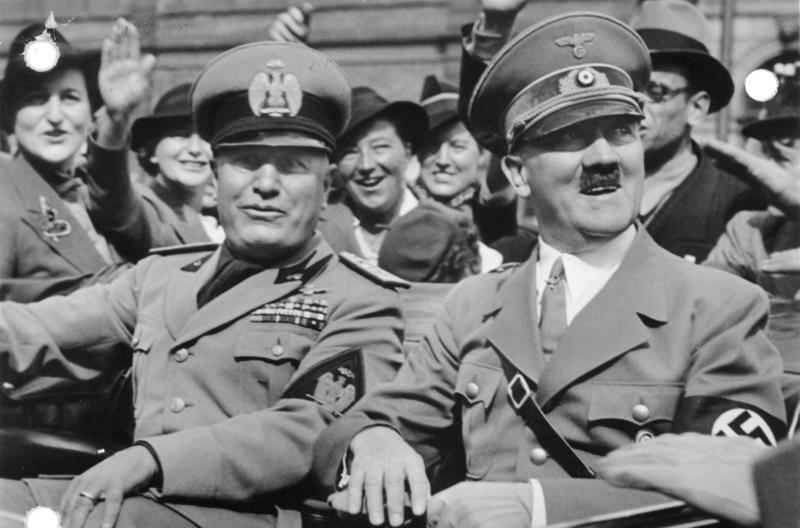
Dictators of Axis powers Italy and Germany : Mussolini and Hitler
Image: Bundesarchiv, Bild 146-1969-065-24 / CC-BY-SA 3.0,
CC BY-SA 3.0 DE, via Wikimedia Commons
The Beginning of the War
On September 30, 1938 Great Britain, France and Germany signed the Munich Agreement. It gave Germany the right to take over the Sudetenland, a part of Czechoslovakia. The two Allies hoped it would satisfy Hitler and keep them out of the war. The agreement, however, was broken and Hitler not only invaded the Sudetenland but took over all of Czechoslovakia.
It was clear that Poland, on Germany’s eastern border, would be the next target. Great Britain and France promised to help Poland if it were attacked. In August 1939 Germany and the Soviet Union signed a “non-aggression pact”, in which they promised not to attack each other. Germany did this so that it would not have to fight on two fronts.
On September 1, 1939 Germany invaded Poland and World War II began.
Adolf Hitler and the Rise of the NSdAP

Image: Bundesarchiv, Bild 183-H1216-0500-002 / CC-BY-SA, CC BY-SA 3.0 DE, via Wikimedia Commons
Adolf Hitler was born in Braunau, Austria on April 20, 1889 and spent most of his childhood in Linz. He was not a very good student and dreamt of becoming a painter. In 1913 he moved to Munich and volunteered for the Germany Army when World War I broke out.
Germany lost the war, and the Treaty of Versailles punished the country very severely. It lost its overseas colonies and had to give up its Saar coal region to France. It was only allowed to have a small army and building ships was forbidden. The treaty also made Germany pay a lot of money to Great Britain and France for the damage caused by the war. Hitler was angry at the Allies because he thought they had treated his homeland in an unfair way.
After the war life became very difficult for the Germans. The Great Depression forced many of them out of work and made money almost worthless. Many Germans believed that only a strong leader could make their nation proud again.
After returning to Munich Hitler became the leader of the National Socialist German Worker’s Party, or Nazis. The party’s emblem was an old hooked cross called swastika . Hitler was a powerful speaker and crowds of followers came to his meetings.
In 1923 Adolf Hitler tried to overthrow the German government. He failed and had to go to prison for nine months. There he wrote his book “Mein Kampf”. In it he looked for solutions to Germany’s problems.
Hitler spoke in a style that many people liked. He blamed Jews, Communists and other groups for all the problems that the country had and said that only if pure Germans, which he called Aryans, controlled the country it would return to greatness .
By January 1933 Adolf Hitler and his National Socialist party took over power. He became a dictator, a leader with complete control and created the Third Reich. The Nazis acted quickly against everyone who was against them. They outlawed all other political parties. People who opposed the new government were often murdered.
Once in control he started persecuting the Jews. He also began strengthening the German army and creating jobs for the population. This made him increasingly popular among many Germans.
The Nazis tried to get teenagers to follow Adolf Hitler and his party. These teenagers were organized in groups called the “Hitler Youth” where they chanted Nazi slogans and sang songs in honour of the Fuehrer.
By 1944 the war was going badly for Hitler and the Third Reich. Some of his officers wanted to end the war and save the country from destruction. They tried to kill him by planting a bomb in his office, but Hitler escaped without injuries. Eventually he realized that Germany had lost the war. He committed suicide on April 30th 1945 in Berlin. Eva Braun, his mistress, died with him.
The Blitzkrieg
On September 1, 1939 Germany invaded Poland and World War II began. At the same time the Soviet Union attacked Poland from the east. It was divided among the two countries before the Allies were able to help.
Germany’s attack was carried out with fast tanks and troops that were supported by warplanes. Because the German army moved very quickly this phase of the war was called “Blitzkrieg”.
In the following spring Germany invaded Norway and Denmark. Both countries were occupied by the German army by June. On May 10, 1940 Hitler’s troops invaded the Low Countries- Belgium, the Netherlands and Luxembourg and days later they surrendered.
In the middle of May German soldiers crossed into France and by June 14 the Germans had entered Paris. On June 22 France signed a peace agreement with Germany. German forces then occupied northern France and the Atlantic coast. A new government that was friendly to the Germans was formed in Vichy. On the other side General Charles de Gaulle escaped to Great Britain and started his free French movement. In a radio broadcasts he urged the French people to fight against the Germans.
The Battle of Britain
Hitler next wanted to invade the island of Great Britain. He attacked the British Air Force in order to control the skies over the island. It was history’s first major air battle.
In June 1940, the German Luftwaffe began bombing airfields and other targets in southern England. German warplanes attacked from airports in France. At the end of the battle the British had shot down about 1700 German planes. Hitler saw that he could not defeat England’s air force , so he gave up his idea of invading Britain. Instead, he sent the Luftwaffe to bomb British cities and towns. In London alone, more than 12,000 civilians were killed.
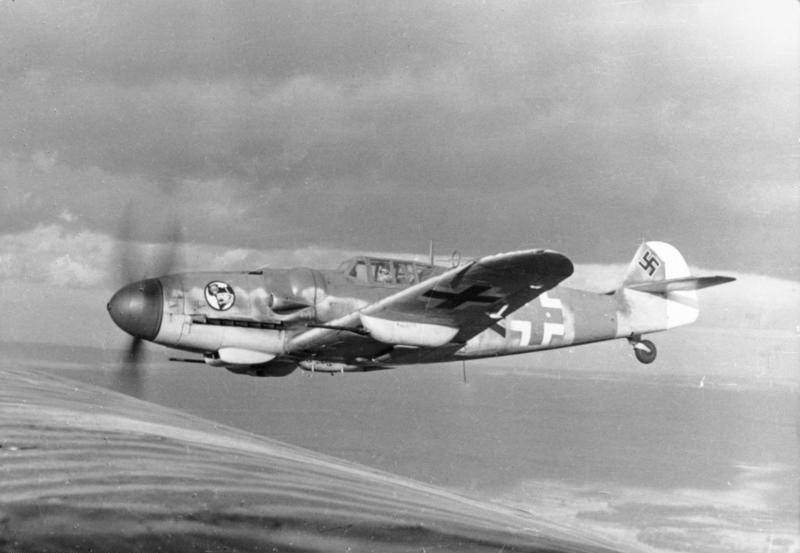
German Messerschmidt bomber during the Battle of Britain
Image: Bundesarchiv, Bild 101I-662-6659-37 / Hebenstreit / CC-BY-SA 3.0,
CC BY-SA 3.0 DE, via Wikimedia Commons
The Battle of the Atlantic
During the war Great Britain got most of its food, war materials and other supplies from North America. Throughout the war Germany tried to destroy the ships that brought goods to the island. German U-boats or submarines were the biggest threat to the British navy. At first, these U-boats were very successful in tracking down British cargo ships and sinking them. They often attacked in groups called wolf packs.
To survive such attacks British ships travelled in groups called convoys. They were protected by destroyers and also supported by planes. As time went on America gave British ships more and more protection.
In 1943 the Allies began to escort the convoys with small aircraft carriers. The planes that could take off from the carriers and long-range bombers from land began to attack and destroy more and more German submarines. The Allies began winning the sea war also because they started using an underwater radar system called sonar to locate submarines. By the middle of 1943 the Allies were sinking U-boats faster than the Germans could replace them.

Officers on board a British destroyer on the lookout for German U-boats
Post-Work: User:W.wolny, Public domain, via Wikimedia Commons
The Holocaust
Under Adolf Hitler the National Socialist German Worker’s Party became very powerful in Germany from 1933 to 1945. The Nazis, as they were called, wanted to get rid of people who they thought were not as good as they were. They especially hated Jews and thought they were evil. At the beginning they made life hard for the Jews in Germany and all over Europe. Later on, they decided to kill them. This mass killing was called the Holocaust.
After 1939 about 6 million Jews were killed in the countries that Hitler controlled. But Jewish people were not the only ones murdered by the Nazis. Gypsies, homosexuals, mentally and physically disabled people and others who were against Hitler were killed in the Holocaust.
Hating Jews and treating them badly is called anti-Semitism. Hitler started this as soon as he became chancellor of Germany in 1933. Jews lost their jobs and their shops were closed and often destroyed.
In 1935 the Nazis passed a new law . Jews were no longer citizens of Germany and they were not allowed to marry other Germans. They lost all of their rights. Every Jew had to wear a yellow Star of David. Many Jews were afraid of Hitler and tried to escape before World War II started.
On November 9th and 10th, 1938 the Nazis destroyed all Jewish synagogues and other public places the Jews went to. This event was called the “Kristallnacht” or “Night of Broken Glass”.
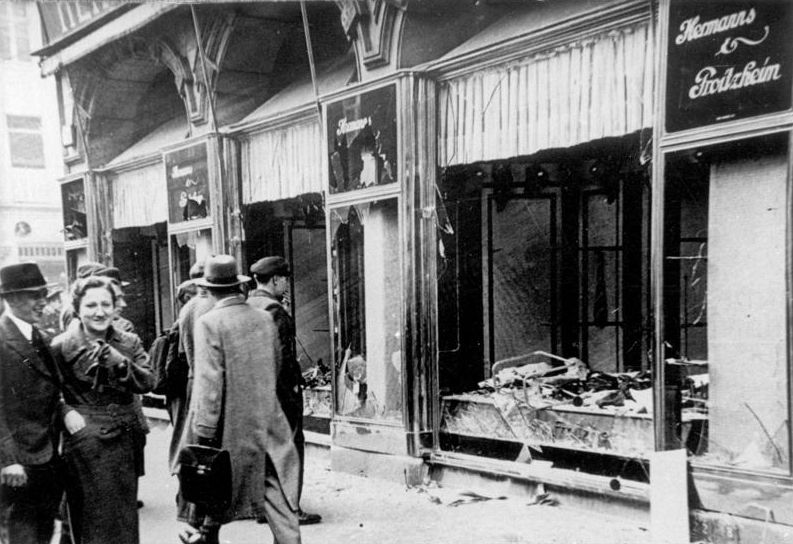
Shop destroyed in Magdeburg during the Night of Broken Glass
Image : Bundesarchiv, Bild 146-1970-083-42 / CC-BY-SA 3.0,
CC BY-SA 3.0 DE, via Wikimedia Commons
Soon thousands of Jews were arrested and locked up in special camps. Others had to live in overcrowded parts of cities called ghettos where they got nothing to eat and suffered from many diseases. The most famous ghetto was in Warsaw, Poland. About half a million Jews had to live in an area that usually was home for 10,000 people. By 1943 only 70,000 had survived.
The Nazis decided that they had to solve what they called “the Jewish problem” once and for all. On January 20, 1942 the Nazi leaders met at the Wannsee Conference near Berlin and decided that all Jews should be killed.
All across Central Europe the Nazis built special death or concentration camps to kill Jews and other people who were not worth of living. The biggest camps were built in Poland. Some well-known camps were Auschwitz, Treblinka, Dachau, Sobibor and Belzec.
At first, the outside world thought that these camps were places where Jews and other prisoners had to work. A sign reading “Arbeit macht frei” hung over the gate at Auschwitz.
Those who were lucky became slaves. They had to work hard and didn’t get enough to eat. Some of them died of starvation. Most of the Jews, however, were brought to the gas chambers that often looked like big showers. There they were killed with poison gas, then taken away and burned.

Main entrance at the Auschwitz concentration camp
Image : xiquinhosilva, CC BY 2.0, via Wikimedia Commons

Selection ramp at Auschwitz – Birkenau.
Jews were either sent to work or directly to the gas chamber
Image : Yad Vashem , Public Domain
Although the countries that fought against Hitler knew about the death camps there wasn’t anything they could do about them.
Many Europeans who were against Hitler’s ideas tried to help the Jews. They often hid them, gave them false documents and helped them escape. A famous book called “The Diary of Anne Frank” tells the story of a Jewish girl whose family hid in Amsterdam for two years but were then caught.
Hitler killed himself shortly before the war was over because he realized that he had lost. When it ended in 1945, Allied soldiers entered Germany. They liberated the concentration camps but were shocked when they saw what had happened there.
Jews who survived the Holocaust had no place to go. They waited to find a new home. In 1948, the United Nations decided to give homeless Jews a new place to live. The state of Israel was founded and hundreds of thousands of European Jews went there to start a new life.
The Holocaust is one of the most terrible periods of human history. In many countries memorials have been built to remember those who died. Museums in Europe and America try to show what happened and help our generation understand the horrors of the Second World War.

Holocaust memorial in Berlin
Image: K. Weisser, CC BY-SA 2.0 DE, via Wikimedia Commons
Operation Barbarossa – Invasion of the Soviet Union
Although Adolf Hitler conquered many western European countries during the first years of the war, he saw the Soviet Union as his main enemy. He was afraid that the Russians would expand towards central Europe and he also wanted to control the Soviet wheat and oil fields. Hitler signed a treaty with dictator Joseph Stalin in 1939 that would keep the Soviet Union out of the war while he overran western Europe.
On June 22, 1941 Germany started Operation Barbarossa—the invasion of the Soviet Union. The attack surprised the Soviets and German tanks smashed through the Russian battle lines. In the first few weeks hundreds of thousands of enemy soldiers were captured. As the Germans went forward, the Soviet population destroyed factories, dams, railroads, food supplies and other things that might help the Germans. The Germans were heading for a fast victory but then they started making mistakes.
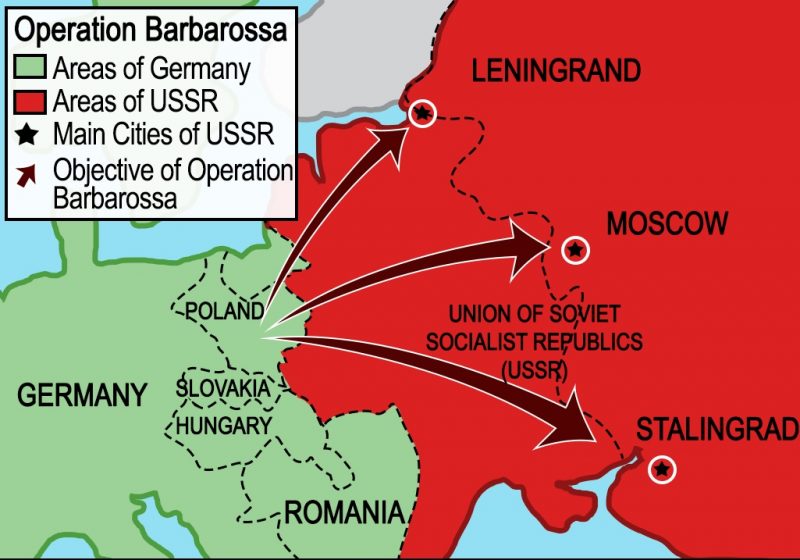
Germany attacks the Soviet Union
Image: Dhammika111, CC BY-SA 4.0, via Wikimedia Commons
Hitler’s generals wanted to capture Moscow before the winter started but Hitler himself had a different plan. He ordered the German army to wait until new forces came to help them. This gave the Soviets time to strengthen their army. By December 1941 the Germans had surrounded Leningrad and were in the suburbs of Moscow. But then a harsh winter set in early and temperatures dropped to –40°C. German troops did not have enough clothing and many soldiers suffered from frostbite. Tanks and other weapons broke down in the bitter cold. The Russians started a counterattack and the German army had to retreat.
Although Hitler had lost many soldiers and a lot of Russian territory his army was still strong enough to continue fighting. In the summer of 1942, he turned his attention to the Caucasus, an oil-rich mountainous region in southern Russia. In August Hitler attacked Stalingrad. It was the biggest battle of World War II. German artillery destroyed the city, but the Russians defended it with what they had left. When winter began they counterattacked and drove the Germans back. After having lost more than 200,000 men the German army surrendered at the end of January 1943. The defeat was the worst that Nazi Germany suffered, and Stalingrad became a turning point in the war.
The Germans had to withdraw from the Caucasus and as time went on the Soviets drove them out of their whole country. From this point on the Russian army got stronger and stronger and started their march towards the west.
Pearl Harbour – America Enters the War
When war broke out in Europe in 1939 Japan decided to start expanding its territory to the Asian mainland. The Japanese occupied parts of China and conquered Indochina as well. The United States was against the Japanese invasion of Asia. They thought they could stop them by halting the sales of petroleum and other raw materials which the Japanese desperately needed. Japanese generals realized that only the United States had the power to stop them. The American navy was so strong that it had to be destroyed.
On the morning of December 7, 1941 Japanese warplanes attacked U.S. warships at Pearl Harbour naval base in Hawaii. It came as a complete surprise to the Americans. Within hours bombs and torpedoes sank six American ships and killed more than 2,000 Americans. The Japanese had destroyed the heart of the American fleet.
The next day the United States declared war on Japan and a few days later on the other Axis powers, Italy and Germany.
The attack on Pearl Harbour was the beginning of the war in the Pacific. On the same day the Japanese also invaded the Philippines and attacked Hongkong. In the first few months the Japanese were very successful and captured many important islands but in June 1942 the tide turned . A strong fleet of Japanese warships wanted to capture Midway Island. American warplanes attacked from aircraft carriers and destroyed much of the Japanese fleet.

American battleship USS West Virginia destroyed during the attack on Pearl Harbour
Image : U.S. Navy, Office of Public Relations,
Public domain, via Wikimedia Commons
D-Day – Allied Forces Invade Europe
The Germans had been expecting an Allied invasion of Northern France for long time. However, they were not sure where the invasion would take place . The Germans concentrated their troops near Calais because it was nearest to the British Isles.
Early on June 6,1944 Operation Overlord, the code name of the invasion, began. Commanded by Dwight D. Eisenhower about 3,000 ships and 176,000 soldiers crossed the English Channel and landed, to the surprise of the Germans, on the beaches of Normandy, much farther to the west than Hitler’s generals had expected. Paratroopers dropped behind the German defence lines and captured bridges and railroad tracks.
Although Germany was surprised by the attack, they fought back fiercely . At one landing site, named Omaha Beach, Allied troops came under heavy fire and had difficulty staying on the shore. At the end of the day, Allied forces had managed to secure the coastline and create a harbour where more troops could land. By the end of June, 1944 about a million Allied troops had reached France.
After heavy fighting, American and British armies were able to move inland . They captured Paris on August 25, 1944. After advancing to eastern France and Belgium the Allied offensive moved on but as winter came was halted west of the Rhine River.
Hiroshima and Nagasaki – Japan Surrenders
In 1939 German born scientist Albert Einstein informed US president Roosevelt about the possibility of making a super bomb that would cause an explosion that nobody had ever seen before. Large amounts of energy could be released by splitting an atom. Einstein and other scientists were afraid that the Germans could develop such a bomb first. In 1942 the Americans set up the Manhattan Project, a secret program to make such a bomb. The first atomic bomb was tested in the New Mexican desert in July 1945.
Even though the United States was winning the war against Japan some generals thought that they would have to invade the island nation to defeat the Japanese. Experts thought that hundreds of thousands of American soldiers might die in such an attack.
After the death of Franklin D. Roosevelt, Harry Truman became president. He learned about the successful test of the bomb. In July 1945 Truman warned the Japanese that the United States would destroy the country with a powerful bomb if they did not surrender at once. In spite of the warning Japan continued fighting.
On August 6,1945 an American bomber, the Enola Gay, dropped the first atomic bomb on the Japanese city of Hiroshima. The explosion killed 70,000 to 100,000 people and destroyed about 13 square kilometres of land. Three days later a much larger bomb was dropped on Nagasaki. It killed about 40,000 people. Thousands of people died of injuries and radiation in the years that followed. On August 14, the Japanese government agreed to surrender. Many officers committed suicide. On September 2, 1945 World War II officially ended.
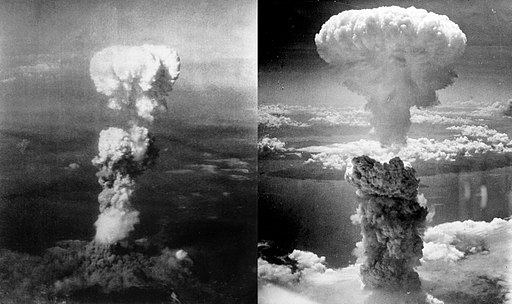
Mushroom clouds over Hiroshima and Nagasaki
Image: George R. Caron,
Public domain, via Wikimedia Commons
Life During World War II
Resistance Groups
Even though most of the population supported the rulers in the Axis countries many people were against them. Resistance groups emerged in almost all of the countries that the Axis occupied. These groups worked together in an attempt to overthrow the ruling parties and dictators. They published and distributed illegal newspapers to inform the population. They rescued Allied pilots who were shot down and gathered information about the enemy. Bombing bridges and important roads was also a part of their work.
Some of the work of these groups turned out to be very important in the war. The French resistance helped the Allies during the Normandy invasion in 1944. Yugoslavia had the most effective groups of all. Partisans drove the Germans out of Yugoslavia in 1944.
Even in Germany itself there was a small underground group that was against the Nazis. In 1944 , a group of German army officers planted a bomb that was to kill Hitler. The bomb exploded near the Fuehrer but he escaped with minor injuries.
Those who worked against the Nazis risked a lot. If they got caught, they were almost always killed. Sometimes the Germans gathered hundreds of civilians and shot them as an act of revenge.

Meeting of a French resistance group
Image: Donald I. Grant, Department of National Defence,
Public domain, via Wikimedia Commons
Propaganda
All the nations that were in the war used propaganda to help support their ideas. Radio broadcasts reached many people. Films and posters were also used . In Nazi Germany Joseph Goebbels controlled the media. He wanted to convince people all over the world that Germany was the most powerful nation and that the Germans had the right to rule the world.
Many Germans listened to radio programmes of the Allies. The BBC broadcast news programmes to the mainland to inform the people of the real situation of the war.
Life in Germany
Germany’s early victories started to make people believe in the war. There was enough food and clothing during the first years and goods came in from the countries that the Nazis occupied. But the situation changed by 1942. The army was defeated on the Russian front and there were fewer reports of victories to cheer people up. The Allies bombed German cities and towns day and night. Yet the people continued to work for the war.
Everyone was afraid of Hitler’s secret police, the Gestapo. They arrested everyone that was against Nazi beliefs in Germany and other countries.
Life in the United States
In the United States and Canada most people supported the war. They hated the Nazis and wanted to defeat the Axis powers, especially the Japanese, who bombed Pearl Harbour. America produced an enormous amount of weapons for the war. Old factories were turned into weapons industries, car factories began producing tanks and aircraft.
Millions of women started working in the war production after the men had left for Europe. They worked in shipyards and aircraft factories and replaced men on farms.

American woman working in a factory during World War II
Image: Alfred T. Palmer, Public domain, via Wikimedia Commons
Life in the Soviet Union
Life was especially difficult in the Soviet Union, where intense fighting went on for four years. Stalin ordered his retreating soldiers to burn down everything in their way, so that they didn’t leave anything behind for German soldiers to use. But this also caused great problems for the Soviet population. Millions of civilians died of starvation and diseases.
The End of the War
The Soviet victory at Stalingrad ended Germany’s advance in eastern Europe. In the following years, the Soviet army received supplies from Great Britain and the United States and started moving westward.
Soon after the Normandy invasion Stalin’s armies attacked along a 700 km front. In July 1944 Soviet troops reached Warsaw and in the following months drove the Germans out of most of eastern Europe.
The final attack on Germany began in early 1945. Soviet soldiers reached the Oder River, about 65 km east of Berlin and Allied forces set themselves up along the Rhine River by March.
By this time, it was clear that Germany could not fight much longer, even though Hitler ordered his men to fight to their deaths. A large number of German soldiers surrendered to the Allies every day.
The Allied leaders– U.S. President Franklin D. Roosevelt, British Prime Minister Winston Churchill and Soviet Premier Joseph Stalin—met in Russia for the Yalta conference. There they planned Germany’s defeat and the occupation of the country.
Meanwhile the Soviet army pushed on through Germany and by April 25, 1945 they had surrounded Berlin. Adolf Hitler realized that the war was over and committed suicide in his bunker on April 30. Germany surrendered on May 8, 1945.
As they marched on through Germany Allied soldiers discovered terrifying evidence of Nazi brutality. Even though they freed death camps thousands died of starvation after Germany’s surrender.

Churchill, Roosevelt and Stalin at the Yalta Conference
Image: Photograph from the Army Signal Corps Collection in the U.S. National Archives.,
Public domain, via Wikimedia Commons

German commander surrenders
Image: Lt. Moore (US Army); restored by Adam Cuerden,
Public domain, via Wikimedia Commons
Results and Aftermath of World War II
After the end of the war, a conference was held in Potsdam, Germany, to set up peace treaties. The countries that fought with Hitler lost territory and had to pay reparations to the Allies. Germany and its capital Berlin were divided into four parts. The zones were to be controlled by Great Britain, the United States, France and the Soviet Union. The three western Allies and the Soviet Union disagreed on many things and as time went on Germany was divided into two separate countries: East Germany , which had a Communist government and West Germany, which was a democratic state . Berlin was divided into East and West Berlin. Austria was also occupied by the four Allies from 1945 to 1955.

German occupation zones after World War II
Image: svg version created by glglgl, CC BY-SA 3.0,
via Wikimedia Commons
One by one, the Russians started to take over countries in eastern Europe and install Communist governments there. The division of Europe was the beginning of the Cold War between the democratic nations of the west and the Communist countries of eastern Europe. The Iron Curtain marked the border between these two regions.
After the war many Nazi leaders were arrested and punished for what they had done in the war. The most famous war trials were held at Nuremberg, Germany. Those who were responsible for brutal crimes were sentenced to death.
Many problems arose after the war was over. One of them focused on the city of Berlin which was deep inside the Russian zone. In June 1948, the Soviet Union tried to drive the western powers out of Berlin by blocking all routes to the city. For a whole year the Allies flew in food, fuel and other things that the population needed to survive. Finally, the Russians gave up and the blockade ended. In 1961 the East Germans built a wall around Berlin to stop their citizens from escaping to the west.
The biggest task was to rebuild Europe, which lay in ruins. In 1948 the United States set up the Marshall Plan to help Europe’s economy. 18 nations received 13 billion dollars worth of food machines and other goods.
During World War II, four of the Allied powers—the United States, Great Britain, the Soviet Union and China— agreed to create an organization that should work for peace . In April 1945 fifty countries signed a charter and gave birth to the United Nations.
Key Figures of World War II
Benito Mussolini founded Fascism and ruled Italy as a dictator for more than 21 years. He dreamed of making Italy into a great empire. He banned all other parties and took control of industry, schools, the police and the media. Il Duce joined an alliance with German dictator Adolf Hitler. Both countries sent soldiers to Spain to support General Franco in the Spanish Civil War. In 1943 Mussolini was arrested but soon later rescued by German commandos. In 1945 Italians who were against fascism captured Mussolini as he wanted to escape to Switzerland. The next day he was shot to death.
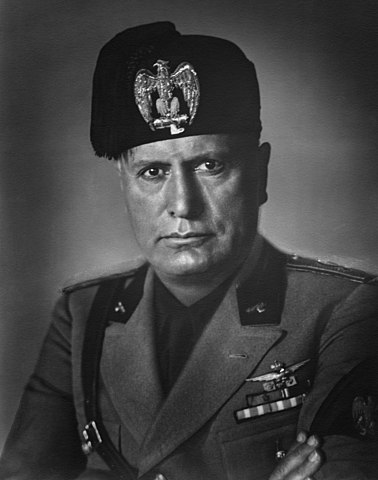
Benito Mussolini
Image: www.historynet.comwww.gettyimages.it,
Public domain, via Wikimedia Commons
FDR, as he was also called, was the only president elected four times. He served for more than 12 years, longer than any other person. Roosevelt became president during the Great Depression, which was a hard time for the American economy . One out of four workers had lost their jobs and many families had no money to buy food or clothes. President Roosevelt created a programme called the New Deal in which the government helped poor people, gave them work and paid for food and shelter. President Roosevelt tried to keep America out of World War II, but when the Japanese attacked Pearl Harbour the United States entered the war. Roosevelt was a strong leader throughout the war. He died shortly before the war ended in 1945.

Franklin D. Roosevelt
Winston Churchill was the Prime Minister of Great Britain during the Second World War. He was a strong leader and a talented speaker, writer and painter. Churchill held speeches that gave the British people hope and courage during the horrible years of the war. After Germany’s surrender in 1945 Churchill lost his job as Prime Minister but returned in 1951. In 1953 he won the Nobel Prize for Literature.

Winston Churchill
Image : BiblioArchives / LibraryArchives, CC BY 2.0,
via Wikimedia Commons
Joseph Stalin was the dictator of the USSR from 1929 until 1953. During his rule, the Soviet Union became one of the world’s greatest powers. In the late 1800s Stalin joined a group of Marxist revolutionaries. Although Stalin had not played a big role during the Russian Revolution, he started gaining power. When Lenin died Stalin took control. He was a ruthless dictator, in many ways like Hitler, and had millions of people killed or exiled because they threatened his power or opposed his plans. After World War II the Soviet army stayed in the eastern part of Europe and Stalin set up communist governments there.

Joseph Stalin
Image Unknown authorUnknown author; image flipped by Gaeser,
Public domain, via Wikimedia Commons
Harry Truman became American president in the spring of 1945, shortly before the war in Europe ended . In August of the same year Truman decided to use the atomic bomb to end the war against Japan

Harry Truman
Image: National Archives and Records Administration. Office of Presidential Libraries. Harry S. Truman Library.,
Public domain, via Wikimedia Commons
Eisenhower became the leader of the Allied forces in Europe. He planned the invasion that led to the end of the war . After the war “Ike” became a very popular figure in the US and was elected president in 1952.

Dwight D. Eisenhower
Image: Eisenhower Presidential Library
Himmler was one of the most loyal followers of Adolf Hitler. As the head of the German police, he ordered the deaths of millions of people. He committed suicide in May 1945 after the Allied troops had captured him.
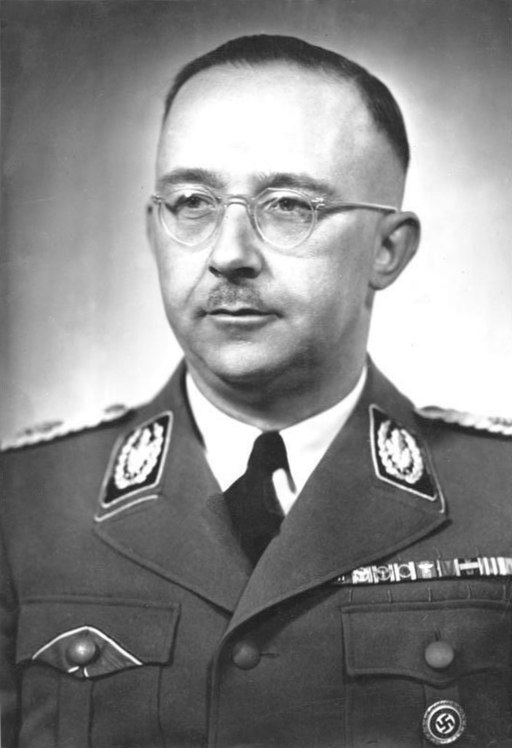
Heinrich Himmler
Image: Bundesarchiv, Bild 183-S72707 / CC-BY-SA 3.0, CC BY-SA 3.0 DE,
via Wikimedia Commons
Goebbels was Nazi Germany’s propaganda minister. He tried to persuade the Germans and the outside world to believe in Hitler’s regime . Goebbels controlled newspapers, radio programmes, motion pictures and the arts in Germany. At the end of the war Goebbels and his wife poisoned their six children and then he asked a Nazi soldier to kill them both.

Joseph Goebbels
Image: Bundesarchiv, Bild 146-1968-101-20A / Heinrich Hoffmann / CC-BY-SA 3.0, CC BY-SA 3.0 DE,
via Wikimedia Commons
General Charles de Gaulle was the most outstanding French patriot, soldier and statesman of the 20th century. He led the French resistance against Nazi Germany and restored order in France after World War II. He was the architect of a new constitution and became president in 1958.

Charles de Gaulle
Image: Bundesarchiv, B 145 Bild-F015892-0010 / Ludwig Wegmann DescriptionGerman photographerAuthority control: Q109374788VIAF: 18152501139410682865GND: 1156657059creator QS:P170,Q109374788 / CC-BY-SA, CC BY-SA 3.0 DE,
via Wikimedia Commons
Timeline of Events
-
1923
-
1931
-
1933
Hitler is appointed German leader
-
1938
Germany, Great Britain and France sign Munich Agreement
Night of Broken Glass – Jewish synagogues and shops are destroyed -
1939
Germany invades Poland. World War II begins
-
1940
Germany invades the Low Countries and France
Battle of Britain begins -
1941
Operation Barbarossa – invasion of the Soviet Union – starts
Japanese attack on Pearl Habour Naval Base -
1942
Battle of Stalingrad
Wansee Conference – Nazi leaders agree on the Final Solution -
1944
D-Day – Normandy Invasion
Attempt to assassinate Hitler fails -
1945
Yalta Conference – Churchill, Stalin and Roosevelt meet
Hitler commits suicide in Berlin
Germany surrenders
Atomic bombs dropped over Hiroshima and Nagasaki
Nuremberg war trials begin
Videos
Exercises
- Multiple Choice Test 1
- Multiple Choice Test 2
- Multiple Choice Test 3
- Words and Definitions 1
- Words and Definitions 2
- Words and Definitions 3
- The Holocaust – Missing Word Cloze
- World War II – Missing Word Cloze
- Anne Frank – Missing Sentence Parts
- Match the Sentence Parts 1
- Match the Sentence Parts 2
- Dates and Events
- Crossword 1
- Crossword 2